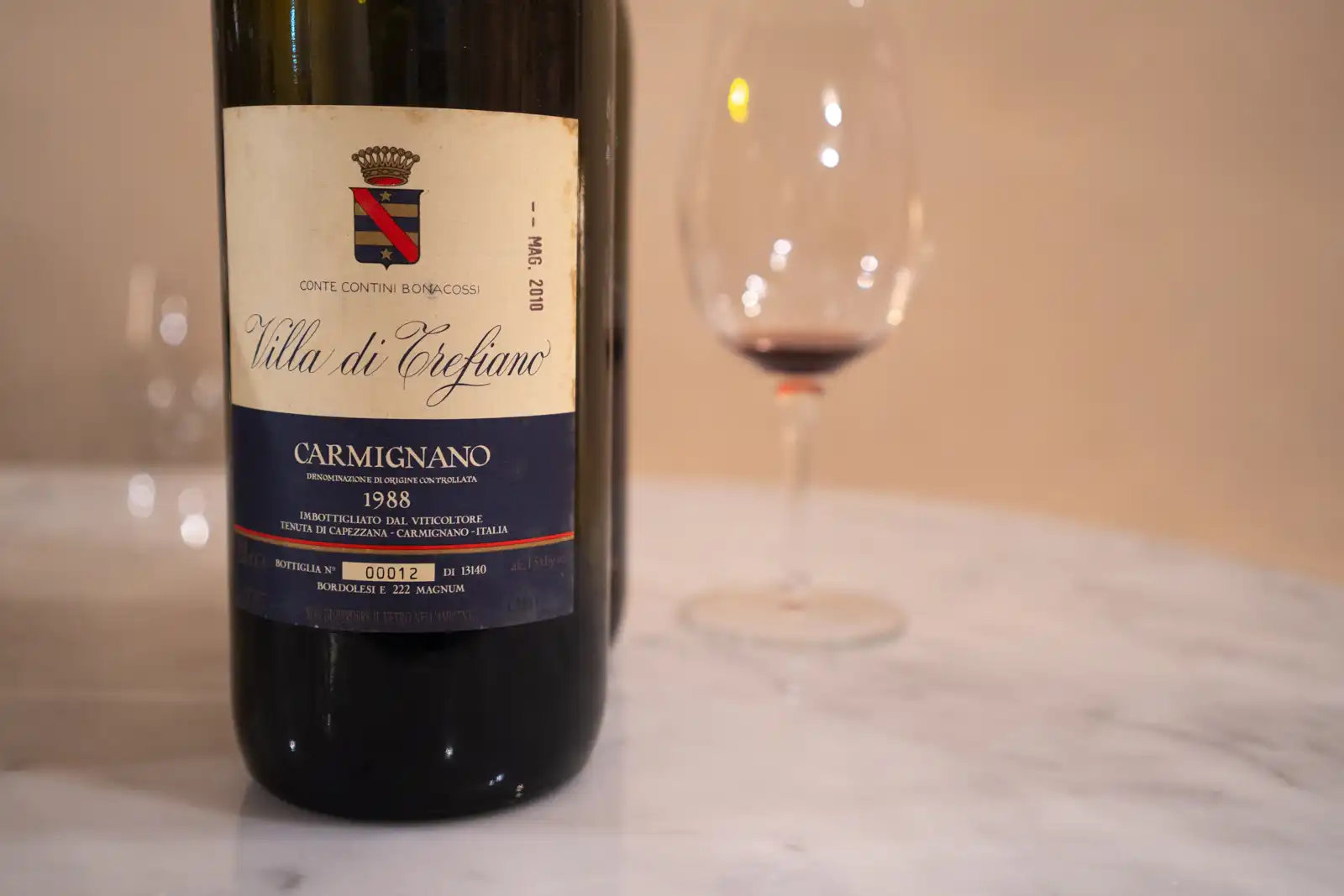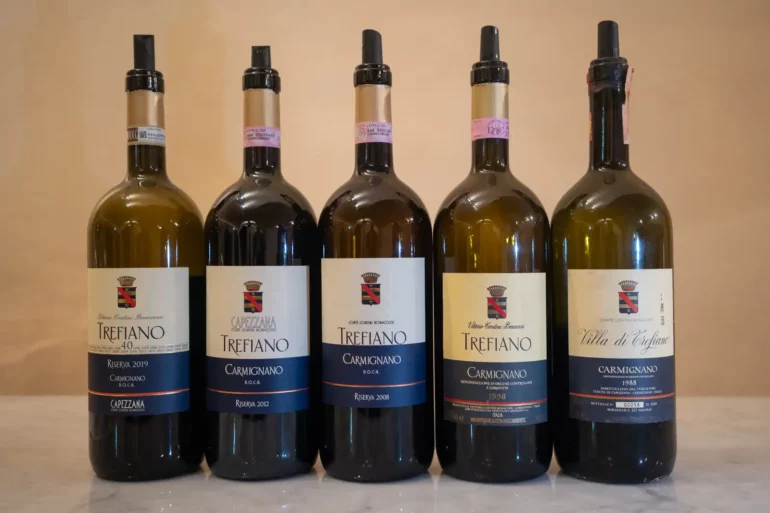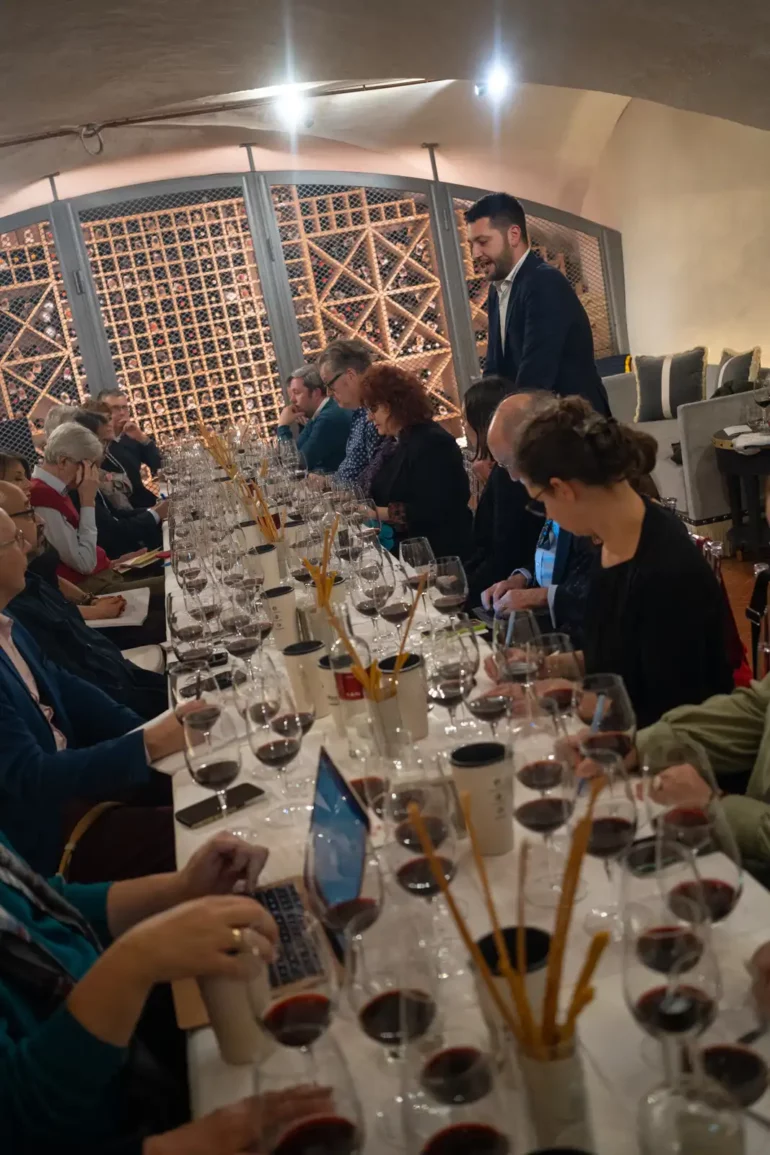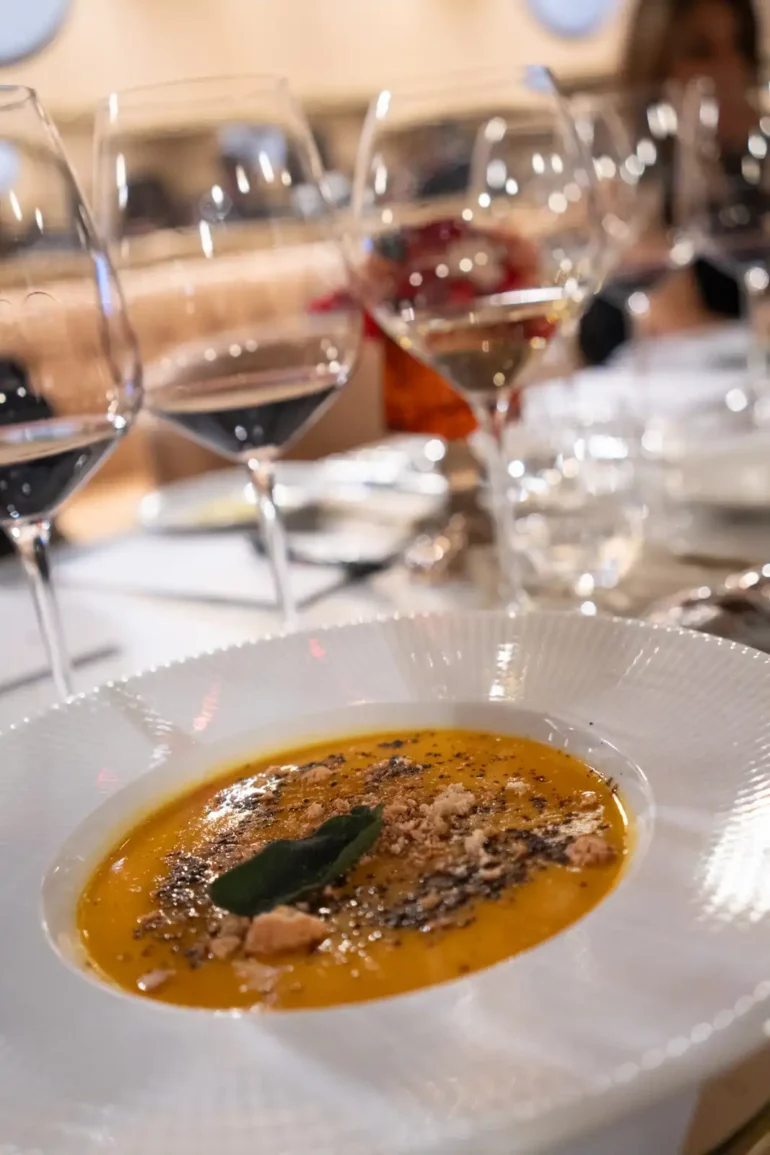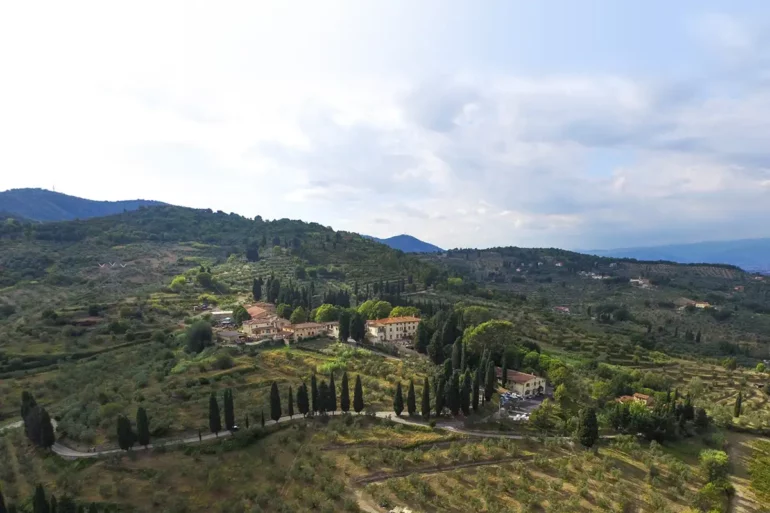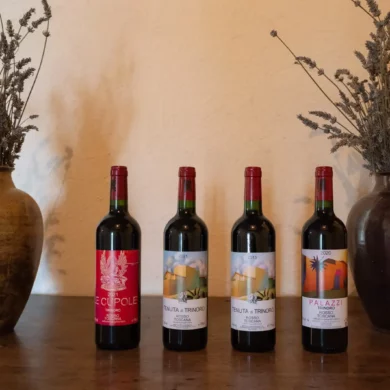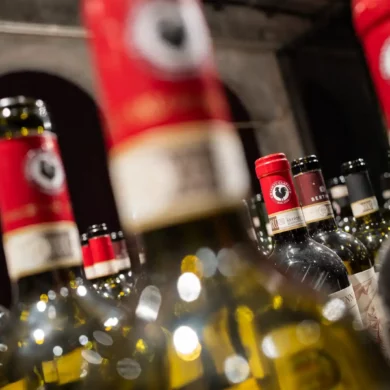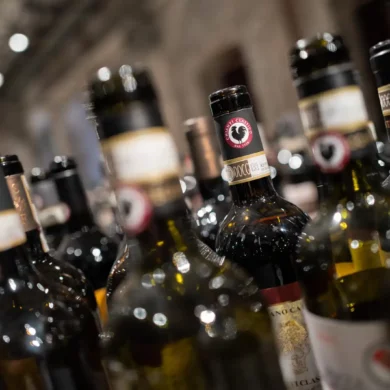By some estimates, Italy has fostered more than 2,000 distinct indigenous grape varieties, of which, some 400 are in commercial production for wine. When you have this much “patrimony” in the vines — to use the word so many Italian winemakers still use — it may seem impossible for Cabernet Sauvignon to generate excitement, especially in Tuscany. After all, Sangiovese is the undisputed voice of this iconic region. Cabernet Sauvignon? That’s sort of a Bordeaux thing, no?
But in the tiny DOCG appellation of Carmignano, west of Florence, Cabernet Sauvignon actually rings with authenticity because of its centuries-old lineage in the terroir. This is particularly the case at Carmignano’s most famous estate, Tenuta di Capezzana, which recently hosted me for a retrospective tasting of their top wine, the “Trefiano” Carmignano Riserva.
Enjoy This Article Free Courtesy of Dalla Terra
Tenuta di Capezzana’s importer Dalla Terra Winery Direct has used a benefit of their Wine Industry Subscription to unlock this article from our paywall so everyone can enjoy it. Learn more about our subscriptions below.
A Settled Debate?
In Tuscany, there has long been a debate about whether Cabernet Sauvignon and Cabernet France have any chemistry with Sangiovese. With its peppercorn spice and muscular dimensions, the particularly popular Cabernet Sauvignon tends to be a bully, especially when it comes from the warmer climes of the coast. In a cuvée, percentages as small as 10% can easily overwhelm Sangiovese’s delicate quartet of cherry-citrus-savory-herbal tones, converting something that is distinctly Tuscan into something familiar and cosmopolitan.
In the 20th century, Italian wine was scrambling for international attention, and to garner it — especially in Tuscany — many producers turned to this fashionable grape as well as other Bordeaux varieties, namely Merlot. The strategy largely worked, but over time, attention has rightly pivoted back to what Italy can do that no one else can: those native grapes.
What many overlook, however, is the extremely long history of Cabernet Franc and Cabernet Sauvignon in pockets of Tuscany, especially Carmignano. They may not be “indigenous,” but they’ve evolved with the climate for long enough to be “typical.”
Defined as one of the four distinct zones of “superior wine quality” by Cosimo de Medici III when he issued the famous Bando edict in 1716, Carmignano has fostered Cabernet Franc or Cabernet Sauvignon in one form or another for more than 500 years. In other words, we can’t pin this on Napoleon or Robert Parker. In fact, that initial introduction was likely the result of the Medicis and their distant dealings, and since that initial introduction predates the known existence of Cabernet Sauvignon, Cabernet Franc was likely the original uva francese of Carmignano.
“The plant has a wonderful evolution system during [its] life,” said Tenuta di Capezzana’s Filippo Contini Bonacossi when I asked why this long history matters for Cabernet Sauvignon. “It has chosen certain part of the genome [based on] the particular condition of the soil or microclimate. So we can tell that the plants have a memory.”
A Forced Reset
But this memory is only extended by the use of massal selection, where new vineyards are propagated from older vine cuttings from the area, rather than clonal selections developed in a nursery. This is a practice that is firmly embraced by Tenuta di Capezzana.
However, before we assume that these vines have been evolving in Carmignano for half a millennium, we need to take into account the phylloxera plague on the late 1800s, which wiped out almost all of the area’s Cabernet, prompting a replant. At Capezzana, Baron Ugo Contini Bonacossi turned to his friends at Château Lafite-Rothschild in Pauillac to procure Cabernet Sauvignon vines for the reboot. This was in the 1960s. That may not seem like a long time evolutionarily speaking, but for the rapidly adapting grapevine, it is still significant. Cabernet Sauvignon from Carmignano has as much of an Italian accent as it does anywhere else in the country.
Today, the disciplinare of the DOCG states that Carmignano wine must be at least 50% Sangiovese, with a mandatory inclusion of either Cabernet between 10% and 20%. The remainder can come from a list of local grapes, such as Caniaolo, but in practice, the bulk of the wine is usually Sangiovese. Again, don’t let those numbers fool you: this is Cabernet country, and Carmignano should be tasted with Cabernet in mind. What they’re rightly protecting is their legacy with this esteemed grape. It’s for us, the passionate wine lovers of all stripes, to decide whether it tastes unique.
About Trefiano
The Contini Bonacossi family makes three Carmignano wines at Tenuta di Capezzana. “Barco Reale” is from the youngest vines and has the largest production volume — a wine with 15% Cabernet Sauvignon and 75% Sangiovese. The “Villa di Capezzana” comes from the oldest vines, but it is not held back as a Riserva and is made every year — a wine with 20% Cabernet Sauvignon and 80% Sangiovese.
Our tasting was focused on “Trefiano,” a wine only made in the best years and which sees 18 months of aging, earning it a Riserva designation. It is a 10% Cabernet Sauvignon wine with 80% Sangiovese and 10% Canaiolo.
Villa di Trefiano was an old, disheveled, 15th-century house when the Contini Bonacossi purchased it from the Rucellai family in the 1920s. It’s 70 hectares of vineyards were highly sought after, as were the 130 hectares of olive trees. With its “chaotic soil composition” — as export manager Pierpaolo Guerra told us — and biodiverse surroundings, the Trefiano vineyard quickly emerged as the Contini Bonacossi family’s top holding. In 1979, they started producing the single vineyard bottling of its best plots, but only in the best years.
What follows is a walk back in time with five of those vintages, starting with the current release.
2019 Tenuta di Capezzana “Trefiano” Carmignano Riserva
With the youngest wine (★★★★ 1/2), one has to calibrate that this is the first impression of Trefiano for a vast majority of drinkers. There is a prominent swath of pure cherry fruit running throughout the whole thing: nose, initial impression, mid-palate, finish. Yet despite this juiciness, it is fairly stoic wine with its arms crossed and its 14.5% alcohol driving the ship. Traces of resinous herbs and leather emerge with a second whiff, and while the lighter body is suggestive of Sangiovese, the flavors are noticeably Cabernet. One is left with the overall impression that it is best to wait a few years to uncork Trefiano.
2012 Tenuta di Capezzana “Trefiano” Carmignano Riserva
With the 2012 (★★★★★), we take a massive leap forward in Trefiano’s evolution. More expansive on the nose and seemingly coming into form, this wine stood out to me for its preserved Sangiovese character with noticeable savory aromatics and resinous herbs as well as an intense edge that reminded me of gin or juniper berries. The vivid and lush cherries of Cabernet Sauvignon come to the fore across the palate, with well-integrated oak and leathery notes, too. This is now an amiable wine, its arms uncrossed, and its hands maybe casually resting in its pockets. I found the tannins to still resemble the coarse cotton of youth.
2008 Tenuta di Capezzana “Trefiano” Carmignano Riserva
With the 2008 (★★★★ 3/4), we seem to reach a tipping point in the evolution of Trefiano: now we are starting to smell like an old Cabernet. The cherry-like fruit seemed to be shifting into darker, more dried-fruit territory, while a black-cocoa edge, quite a bit of mint, an inoffensive touch of horse stable, and coarse linen tannins firmly planted this wine in “aged Bordeaux” territory. There was still plenty of life to the wine, and while I found it captivating, it seemed like a wine in transition. Were the Sangiovese elements — so noticeable in 2012 — in hiding? The family reported that the yields were lower in 2008, which perhaps brought out more of Cabernet Sauvignon’s assertive personality.
1998 Tenuta di Capezzana “Trefiano” Carmignano Riserva
For me, the 1998 (★★★★★) represented the sweet spot. This was winemaker Benedetta Contini Bonacossi’s first vintage, and she has presided over this wine ever since. And what a debut.
Boasting the perfect combination of dried black cherry fruit notes countered by a bitter edge akin to espresso, this wine showed great prowess and poise, while revealing more tertiary characteristics than younger vintages. Furthermore, the savory streaks and herbal touches of Sangiovese were quite noticeable, speaking to the possibility of alchemy between the two great (but often divergent) grapes. Here was the possibility that the long heritage of Cabernet in Tuscany can indeed show up in the glass. There was also a surprising amount of earthiness to this wine, which for me brought to mind pairings with mushroom and truffle dishes. Usually when you have a wine this old, food pairings and cuisine versatility take a backseat on account of the wine’s fragility, but not here. To extend the personification from earlier, this is a wine that is now telling stories and using hand gestures to great effect.
On another note, there is something great about the 1998 vintage. Every time I’ve encountered it — either in Barolo or Champagne, Burgundy or now in Tuscany — it speaks to me of endurance.
1988 Tenuta di Capezzana “Villa di Trefiano” Carmignano
By the time we charted a course all the way back to 1988 (★★★★★), Trefiano was in a very different state of mind. Older, wiser, but perhaps a little less coherent with its poetry, the wine revealed a more lifted and intense set of aromas (espresso, prunes, leather, dried beef and dried mint) yet felt simpler and fruitier on the palate. The tannins were also, somehow, more coarse than the silkiness of the 1998. Yet for all the patterns it defied, I found it engaging and compelling in a free verse sort of way. However, if you have any older vintages of Trefiano, or plan to cellar a vintage for the future, I’d presume the 20- to 25-year mark is the most thrilling window.
Note: All photos ©Kevin Day/Opening a Bottle with the exception of the aerial photo of Tenuta di Capezzana, provided by ©Dalla Terra Winery Direct.

